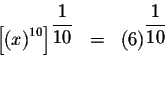 SOLVING LOGARITHMIC EQUATIONS
SOLVING LOGARITHMIC EQUATIONS  SOLVING LOGARITHMIC EQUATIONS
SOLVING LOGARITHMIC EQUATIONS 
Note:
If you would like an in-depth review of logarithms, the rules of logarithms, logarithmic functions and logarithmic equations, click on logarithmic function.
Solve for x in the following equation.
Example 5:
Note that the domain of
![]() is the set of real
numbers greater than zero and not equal to 1 because of the base
restrictions on logarithmic functions.
is the set of real
numbers greater than zero and not equal to 1 because of the base
restrictions on logarithmic functions.



Check the solution
 by
substituting
by
substituting
![]() in the original equation for x. If the
left side of the equation equals the right side of the equation after the
substitution, you have found the correct answer.
in the original equation for x. If the
left side of the equation equals the right side of the equation after the
substitution, you have found the correct answer.

Since the left side of the original equation is equal to the right side of
the original equation after we substitute the value
1.19623119885 for x,
then
![]() is a solution.
is a solution.
You can also check your answer by graphing
![]() (formed by subtracting the right side of the original
equation from the left side). Look to see where the graph crosses the
x-axis; that will be the real solution. Note that the graph crosses the
x-axis at
1.19623119885. This means that
1.19623119885 is the real
solution.
(formed by subtracting the right side of the original
equation from the left side). Look to see where the graph crosses the
x-axis; that will be the real solution. Note that the graph crosses the
x-axis at
1.19623119885. This means that
1.19623119885 is the real
solution.
If you have trouble graphing
![]() convert it to the equivalent equation
convert it to the equivalent equation

If you would like to test yourself by working some problems similar to this example, click on Problem.
If you would like to go back to the equation table of contents, click on Contents.
This site was built to accommodate the needs of students. The topics and problems are what students ask for. We ask students to help in the editing so that future viewers will access a cleaner site. If you feel that some of the material in this section is ambiguous or needs more clarification, please let us know by e-mail.

